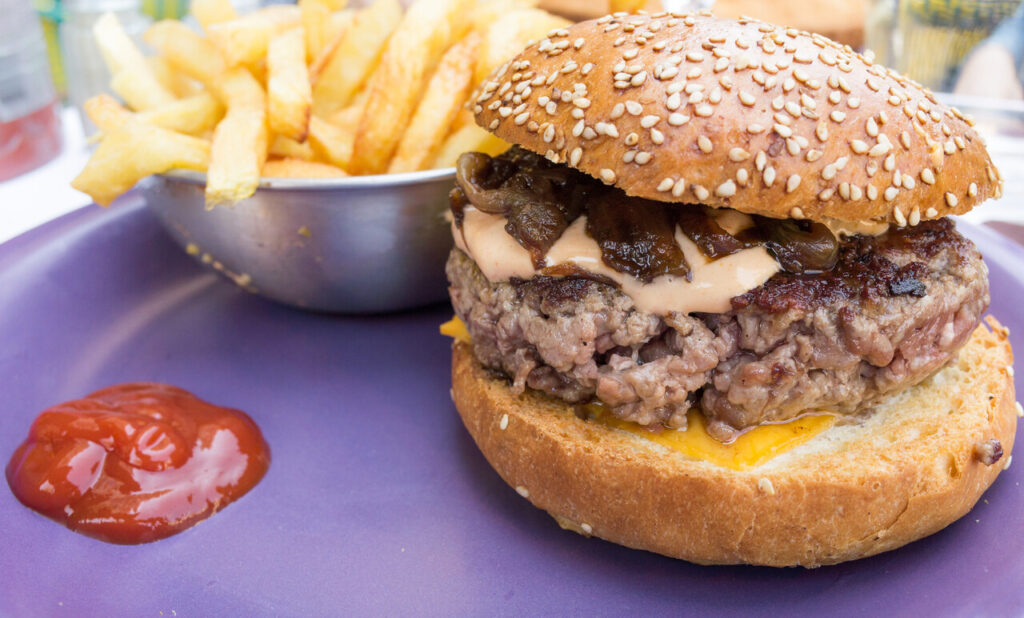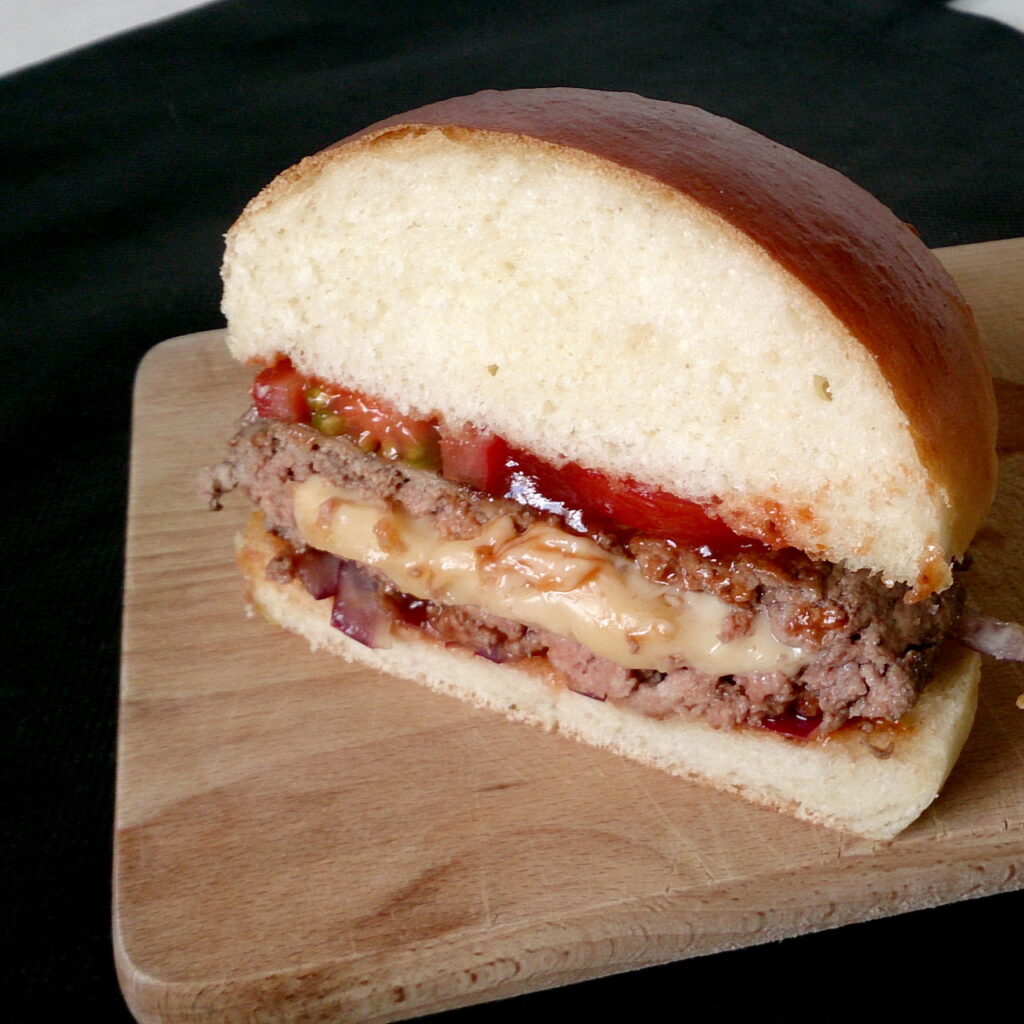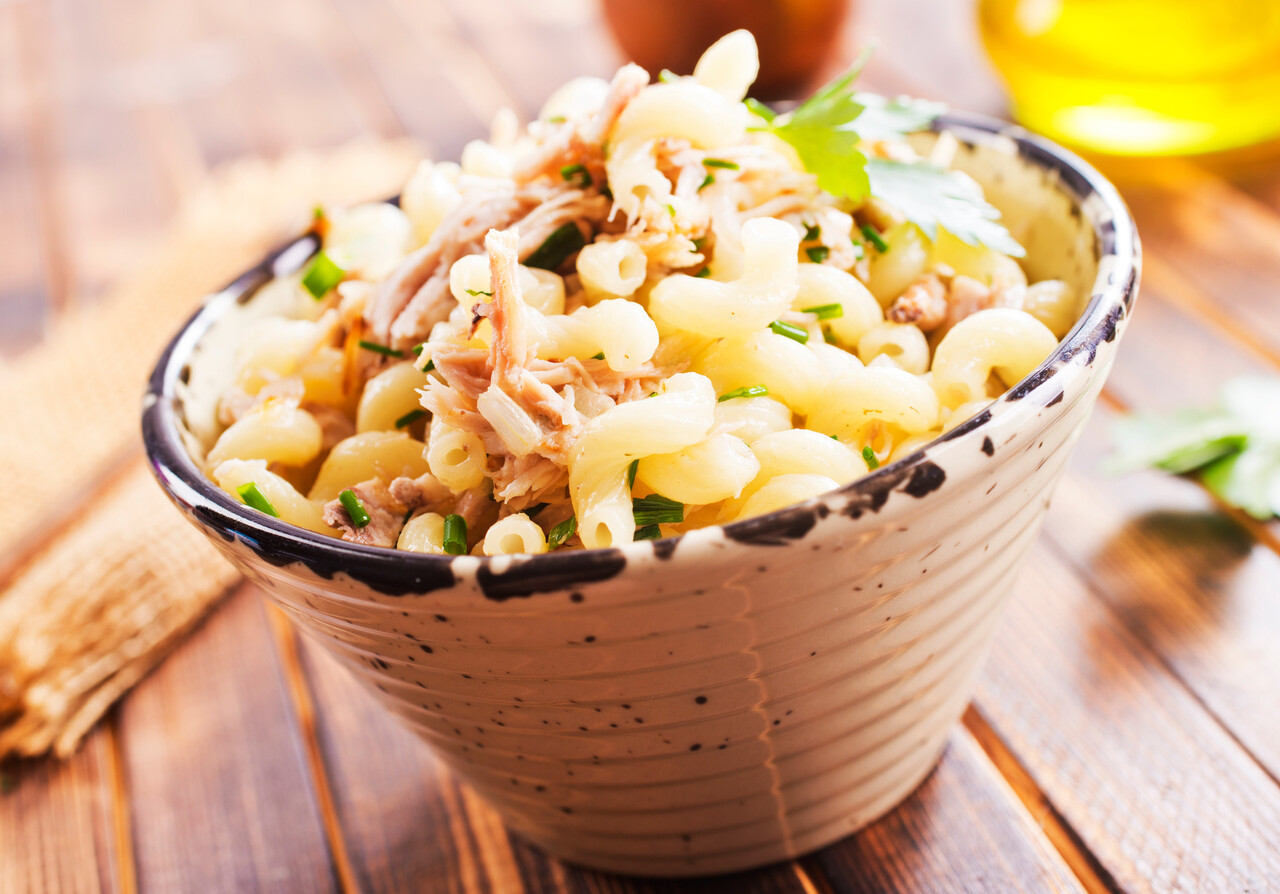What Is a ‘Juicy Lucy’ and Why Is It a Minneapolis Legend?

A single, stuffed burger tells a longer story than its size suggests. The Juicy Lucy is more than a regional sandwich; it is a local invention that became shorthand for Minneapolis food pride, barroom ingenuity, and blunt, cheesy pleasure. The burger’s molten heart turns a simple act of eating into a small performance: order, wait, caution, bite. That ritualistic sequence helps explain why a one-off idea grew into a sustained culinary legend around the Twin Cities.
The Juicy Lucy mixes invention and place. It arrived at a particular time and neighborhood culture where bars served as labs for quick, satisfying food. The result is a recipe that is easy to describe but unmistakable to eat: two patties, cheese sealed inside, and the danger and delight of molten dairy. That combination gave locals a story and gave visitors a taste that they remember long after they leave.
The Birth of the Juicy Lucy

The Juicy Lucy originated in bar kitchens where cooks experimented to stand out. Two establishments claim the invention: one in south Minneapolis and another a few blocks away. Both accounts place the moment in the 1950s, when postwar diner and bar culture was experimenting with quick, eye-catching fare. The debate over who named it and who stuffed the first patty only strengthened the burger’s mystique.
The Contested Origin Story
Two rival bars both tell plausible origin tales, and both still serve versions with loyal followings. Each story emphasizes a single inventive act: placing cheese inside two patties so the dairy remains molten. The rivalry is less about proving authorship than about local identity. For patrons, declaring a favorite is a way to stake a claim in the city’s food map and to root for a neighborhood institution.
The 1950s Innovation Moment
The Juicy Lucy makes sense in the context of midcentury American foodways: diners, bars, and roadside stands pushed simple modifications that could be executed quickly and sold at a small premium. The technique was clever and cheap: it required no new equipment, only a little extra labor, folding cheese into meat. That small procedural tweak created a novel eating experience that spread by word of mouth.
Name and Spelling Differences
Even the sandwich’s name got caught up in local habit. Variants like Juicy Lucy and Jucy Lucy coexist, signaling allegiance almost as much as taste. The alternate spellings became part of the lore, shorthand for where you ate it and which origin story you prefer. In that way the name itself turned into a cultural marker.
What Makes It Unique
At its core, the Juicy Lucy is a structural trick: cheese is enclosed between two thin patties, sealed at the edge, and cooked so the interior cheese turns molten. That trapped dairy changes texture, mouth temperature, and sauce dynamics.
The molten center creates a steam pocket that interacts with meat juices, giving each bite a distinct hot, creamy surprise unlike a standard cheeseburger topping.
The Sealing Technique
Sealing cheese inside two patties is mechanically simple but exacting. Cooks must pinch seams tightly to prevent leakage, shape even patties so heat penetrates correctly, and choose cheeses that melt reliably without separating into grainy fat. Perfect execution keeps the interior molten and the exterior blistered, preserving a contrast between a seared crust and gooey core.
Molten Core and Texture Play
A Juicy Lucy delivers a temperature contrast that’s central to the experience: a hot, liquid interior against a charred exterior. That contrast enhances perceived juiciness and slows flavor release, so the initial bite delivers an immediate savory heat followed by a creamy, lasting richness. The sensation is visceral and memorable in a way a traditional cheeseburger rarely is.
How It Differs from a Regular Burger
Unlike a cheeseburger with a slice on top, the Juicy Lucy uses fat and moisture retention differently. The sealed core minimizes direct contact between cheese and open air, concentrating flavors and shifting the burger’s textural rhythm. It also changes how you eat it: more caution, different bite sequencing, and a communal tendency to warn friends, all part of its distinct identity.
The Rivalry That Fueled the Myth

Two venues claim to have invented the Juicy Lucy, and the ensuing rivalry created a narrative that fed tourism and local lore. Rather than diminishing the burger, this competition gave it a storyline. Fans choose sides not only on taste but on history, neighborhood loyalty, and personal memory, which keeps debate alive and draws repeat visits from locals and visitors alike.
How Competing Bars Built Their Claims
Each restaurant framed its version as authentic by leaning on continuity and atmosphere. They promoted origin stories, preserved recipes, and served the sandwich in rooms heavy with local color. That curation transformed a menu item into a cultural performance, where the place as much as the patty mattered to consumers.
Role of Media and Food Tourism
Local and national media amplified the rivalry, turning a regional specialty into a curiosity for out-of-towners. Coverage fueled visits and comparisons, and the sandwich’s fame spread as writers and TV shows framed the debate as part of a larger American culinary oddity. The attention helped secure the Juicy Lucy’s place on lists and food tours.
How Rivalry Boosted the Legend
The duel made the burger into a must-try challenge: pick a side, taste, and decide. That ritualized consumption encourages repeat sampling and storytelling, turning each meal into a testimonial. Effectively, the rivalry converted a humble bar dish into a city brand that benefits multiple stakeholders.
How the Juicy Lucy Became a Minneapolis Icon
The Juicy Lucy fit a local appetite for accessible, no-nonsense comfort food and for foods that reward communal tasting. Its simplicity made it easy to copy and to vary, so other kitchens experimented with cheeses, seasoning, and buns. Over time, it moved beyond bar counters into larger restaurant menus and became shorthand for Minneapolis culinary identity and pride.
Place in Twin Cities Food Culture
The sandwich became a neighborhood marker and a staple of late-night bars and casual eateries. Residents embraced the Juicy Lucy as a shared culinary boast, one of those local things that define a city’s food personality. It’s as likely to appear on a game day menu as on a tourist’s checklist.
Variations and Imitators
Once the technique was known, cooks began to tweak it. Different cheeses, stuffed mushrooms, and double-stacked versions emerged. Those riffs expanded the sandwich’s reach while keeping the core idea intact. Variation signaled both reverence and playfulness, and helped maintain cultural relevance across generations.
What Writers and Locals Say
Food writers framed the Juicy Lucy as both novelty and craftsmanship, while locals treated it like a culinary family heirloom. The combination of outsider fascination and insider loyalty cemented its status. The sandwich is eaten as much for flavor as for the story it represents.
How to Recognize and Enjoy the Real Thing

Look for a burger that appears sealed at the edges with minimal cheese leakage, a patty cooked through enough to hold structure, and a careful char that signals direct heat. Minimal toppings are common, so the core trick remains the star. When eating, expect a hot interior; small, careful bites avoid burns and maximize the molten contrast that defines the dish.
Hallmarks to Seek
The key signs are the sealed seam, the absence of a melt-slick exterior, and a charred crust that yields to a molten center. The bun often plays a supporting role, soft enough to cradle the burger but sturdy enough to keep juices contained. If you see a cheese puddle on the plate, the execution was less precise.
Tips for Ordering and Eating
Order fresh and ask about the cheese used. When it arrives, let it sit for a brief moment to cool slightly. Use small bites and watch children or impatient diners. Savor the temperature contrast and the interplay of sear and cream. Sharing is common; split one and sample both halves to compare texture and heat.
Recommended Spots and Variations Today
The sandwiches at the original claimants remain pilgrimage items, but many Minneapolis kitchens offer well-made versions. Seek places that emphasize technique over gimmick, and try variations to understand the concept’s range. Sampling multiple spots is the local ritual; taste will tell you which camp you prefer.
References
- Jucy Lucy – wikipedia.org
- The Jucy Lucy: Eating and Understanding Minnesota’s Singular Burger – thrillist.com
- A Local’s Guide to the Best Juicy Lucy in Minneapolis & St. Paul – discoverthecities.com





